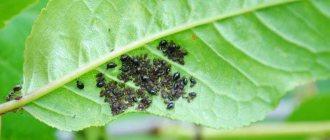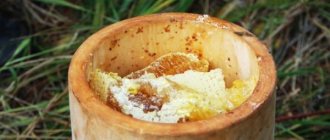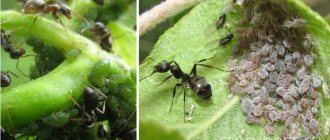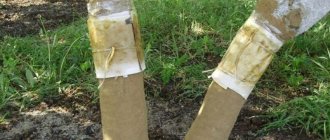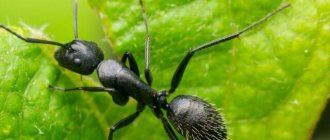Gardeners' spring worries usually begin even before spring arrives. Planning garden maintenance work, new plantings in the beds, selection of varieties and purchase of seeds. And, of course, taking care of the health of the garden and protecting it from pests and diseases. And one of the effective ways to protect a tree from pests overwintering in the soil is a hunting belt. We’ll look at how to make it yourself and install it correctly in this article.
Catching belts are a very effective way to “catch” harmful insects and their larvae. Which can be used throughout the season.
Why are hunting belts needed on fruit trees?
First, let's figure out what a hunting belt is and why it is needed. So, this is a mechanical trap that is placed on the trunk or main branches of a tree to stop pest insects.
Of course, not everyone can be detained in this way, but only those who live, reproduce or winter on the ground, and then crawl up into the crown. These insects primarily include: whiteflies; bukarki; caterpillars; weevils; geese; mites; ants; aphids; flower beetles. When used correctly, a fruit belt on a tree is absolutely safe for people and pets, and also reliably protects the garden from pests. True, it also has a minus - beneficial insects can also be caught in the hunting belt.
When to put on and take off
The design will be effective throughout the season if it is installed in a timely manner. Those funnels that are made double-sided affect both those that climb a tree and those that crawl to the ground to lay eggs.
In spring, belts are put on before the deciduous trees begin to bud. That is, it is better to do this immediately after the snow has thawed.
In summer, you just need to inspect the trees regularly. Trap belts filled with pests should be shaken out and materials replaced.
In the fall, they are removed only in November, before pruning. At this time, moths and other insects come down to lay eggs.
Funnel belt
This type of catch belt can be made in 5 minutes and works great. To construct a funnel belt, you will need a sheet of thick paper or cardboard, rope (twine) or plasticine. Wrap paper around the tree trunk so that an inverted funnel appears on it. Insects will crawl into its wide edge, but the top of the funnel, tightly adjacent to the trunk, will turn out to be a dead end. Tie the upper part tightly with a rope or coat it with plasticine (clay) so that there is no escape for pests. In principle, such a trap works all summer, but it is advisable to check it once a month and update it if necessary.
Barrel preparation
In the spring, with the beginning of insect activity, all cracks in the bark are sealed at a selected height on the trunk. This is especially true for old plantings with rough bark. If the cracks are not covered, the hunting belts will be useless. Ants will pass under the traps along the cracks. You can use clay with sawdust or plasticine as putty.
The place for the fishing belt is prepared at a height of 0.25-0.5 m from the ground. Old dead pieces are scraped off the bark and primed with putty. After preparing the trunk, making your own ant traps in trees is not difficult.
Double-sided funnel
The versatility of this trap lies in the fact that it helps to fight both those insects that are just rising from the soil into the crown, and those that have already been at the top and went to the ground.
To make a double-sided funnel you will need: fabric or burlap 30-40 cm wide;
insecticide; clay; rope or twine. Soak a cloth in the insecticide solution and wrap it around the tree trunk. Using twine or wide tape, secure the center of the fabric tightly to the tree trunk, leaving the top and bottom edges free. Fill the entire space between the free edges of the fabric and the trunk with clay so that insects inevitably end up in the area soaked with insecticides. Change the belt every 3-4 weeks and burn the used one.
How to make
There are several options for making a catch belt. Below we present the most popular ones.
Vegetable oil
Vegetable oil is an affordable product that is always on hand. Apply a generous layer of vegetable oil to the tree bark at a height of 30-40 cm from the soil (replacing vegetable oil with linseed, hemp, etc. is acceptable). Experienced gardeners advise adding a little stove soot to the oil.
Advice! In order to achieve even greater effect from the activities, you can alternate oil barriers and strips with an adhesive base.
Skirt
This method is inexpensive and easy to use. To use it, you need to prepare ordinary kitchen foil in advance. You need to wrap it around the trunk of a fruit-bearing tree in such a way that it looks like a skirt. Ants “don’t like” to get over the sharp edge of this material, and most often they quickly give up, which means they will soon leave the fruit-bearing tree.
Resin or tar
Resin and tar are very popular in the fight against ants on fruit trees. Insects that fall on these Velcro cannot get out of them and die. In order to make a belt using these materials, you must perform the following steps:
- You need to wrap the trunk of the fruit tree in two layers with pre-prepared plastic film at a height of approximately 30 cm above ground level;
- Apply a small layer of resin, tar (solidol or other similar substance) to the surface of the bag;
- The trap must be updated periodically.
Advice! In order to destroy even more ants using a hunting belt, we recommend that instead of adhesive substances, apply a special insecticidal gel to the polyethylene, which is not only a bait, but also a poison for insects. The ant eats the composition, which lures it with a sweet smell, and, getting into the anthill, poisons the rest of its relatives.
Gate trap
Let's imagine another common mechanism in the fight against ants on fruit trees. This is a trap-gate. To install such a trap, you must sequentially perform the following steps:
- on the tree trunk you need to mark a distance equal to 50 centimeters from the ground;
- measure the volume of green space around the perimeter;
- cut a wide strip of rubber equal to the measured volume;
- wrap the cut strip around the tree trunk, bending the edges to make a kind of collar;
- The ends of the rubber are fastened together with glue. The result will be achieved if you use a special adhesive composition against ants, which is toxic and leads to their death;
- As a result of the activities carried out, you will get a rubber container into which you can additionally pour vegetable oil.
Such a rubber gate will need to be periodically changed as the tree grows, and the rubber container will also need to be cleaned of insects and debris that have gotten into it and additionally filled with sunflower oil.
Advice! For long-term use of the trap, it is recommended to make it from soft rubber.
Funnels
Funnel traps are so named because they resemble an inverted cone in appearance. They are quite simple to make. You can easily make them yourself:
- Prepare in advance thick sheets of cardboard, paper, padding polyester, burlap, holofiber, which will be attached to the tree as a trap for ants.
- At a height of 50 cm from the ground, these sheets must be wrapped around the tree trunk so that the lower edges of the paper or padding polyester fit tightly to the trunk. In this case, the upper edge should be at a sufficient distance from the bark of the green space. This creates a funnel effect. An ant, falling into such a trap, will no longer be able to get out of it.
- It is recommended to secure the lower part of the funnel tightly to the tree, additionally strengthening the structure with a rope or wire, and also coat all gaps (if any) with clay.
The structure can be disposed of after use by fire. Unnecessary traps should be burned.
Double-sided funnels
Double-sided funnels are a means of fighting ants that can be used in two directions at once.
Firstly, such funnels prevent insects from climbing up the tree trunk. Secondly, they also act as a barrier to the ants descending for the pupation process.
To install such a structure on a tree trunk, you need to perform the following steps:
- prepare thick paper or cardboard (the width of the sheet of material used must be at least 30 cm);
- the paper must be wrapped around the trunk at a height of about 40-50 cm above ground level, while visually dividing it into three equal parts;
- you need to attach the paper base to the trunk in the middle, taking into account that the upper and lower edges should remain free;
- If there are gaps where the paper is attached to the green space, they must be covered with clay.
Belt-collar
A catching belt-collar is a slightly more complicated design, and you will have to prepare for its creation by purchasing some material, which not everyone has on hand.
Yes, and “consumables” will have to be purchased periodically. But such a trap works great throughout the summer, does not injure the tree, is safe for people and animals, and can also be used for several years in a row, stretching as the tree grows. Intrigued? It's simple! You will need: a piece of soft rubber 4-5 mm thick, 30-40 cm wide and long enough to tightly grip the tree trunk; glue for rubber; bottle of sunflower oil.
Pest trap
Chemical methods of pest and disease control for both purely ornamental and fruit trees have today become almost the absolute norm for growing plants in your own garden. The use of even the mildest chemicals such as insecticides and fungicides is invariably associated not only with environmental considerations, but also with the risk of soil contamination and increased levels of fruit toxicity. Unlike chemical agents, biological and mechanical methods of plant protection are much easier to tolerate by the plants themselves and do not cause such harm to the environment. But they should not be considered absolutely safe and harmless. As with any measure aimed primarily at protecting plants from pests and various garden infections, their impact is largely traumatic and quite “harsh”.
Popular biological measures include the use of decoctions and infusions of plants, microbiological preparations and other products. Along with them, environmentally friendly means of protection also include catching belts - devices for collecting and destroying pests in the form of a tape, which is attached to tree trunks, creating a kind of belt. It plays the role of a trap installed to prevent pests of fruit trees from climbing the trunk and laying eggs on tree branches.
Catching belts are designed to combat insects that cause a lot of harm to the most beloved fruit trees (plums, peaches, apple trees, pears, etc.), such as leaf rollers and codling moths. These insect pests reproduce very actively, their caterpillars cause significant damage not only to crop yields, but also to the tree itself, damaging the ovaries, leaves, branches, bark and even the trunk of majestic woody plants. At the same time, the most common apple, pear, plum, fruit, and oriental caterpillars are just as dangerous as the less common species.
The greatest activity for these pests is typical during the period of fruit formation, during their ripening and harvesting. Caterpillars pose a danger virtually throughout the summer and autumn. As a result of damage by such pests, about half of the crop can be lost. And if you don’t fight, the situation will worsen exponentially.
Hunting belt. © Tasnim Shamma
The collar belt is made as follows:
Measure the circumference of the tree trunk. Cut a strip of rubber of the required size (remember that the rubber must fit tightly around the barrel, otherwise the trap will simply fall off). Wrap a piece of rubber around the barrel and glue it along the cut edge or secure it in another way. Pull the lower part of the rubber upward so that a roller with a recess is formed on the barrel. Pour sunflower oil into the resulting sealed cup. There will regularly be pests in the oil that need to be removed. And it itself will evaporate, so you will have to periodically add more from the bottle. On average, one liter bottle of oil is enough for two large apple trees for a season. You can replace vegetable oil with technical oil - this will not affect the result.
What types of insect repellent belts are there?
Adhesive catching belts
The belt is applied to the wood with special glue
The hunting belt is applied to the tree bark with a special, especially sticky and viscous glue against insects and rodents. This glue is produced in tubes - trademarks “Chisty Dom”, “ALT”, “Napoval”, “Domovoy”, “EUROGARD”, “ECOTRAP”, “ARGUS”, etc.
The glue is made on a polymer base, which contains:
- polyisobutylene (a chemically inactive polymer component that provides moisture resistance);
- polybutylene (providing viscosity, thermoplasticity and fire resistance);
- cycloisan (acting as a catalyst - enhances the effect of the adhesive substance).
Belt in the form of ready-made adhesive strips
Ready-made catching belts are also produced - these are strips of fabric or non-woven material coated with an adhesive composition. Trademark “Your Economy”, “No-guest”, “ARGUS”, “Kapkan”, “Inta-Vir”, etc.
Adhesive spray
Special garden adhesive aerosol is represented by the Green Belt trademark - a 400 ml container. You can, in principle, use any universal adhesive in aerosol form.
The main advantage of the aerosol is uniform and economical spraying. There is enough glue in the can to make more than ten hunting belts. The long shelf life will allow you to use the aerosol for more than one year.
Protective oil belts
Ants do not like to overcome oil barriers. The belt is made with vegetable oil on wood, palm width (10-12cm). You can use any vegetable oil - sunflower, linseed, hemp, etc. You can add stove soot to the oil.
It is allowed to alternate glue strips with oil strips - this results in the so-called “double protection”.
"Repeal" belts
You can make your own and “repellent” belts. To do this, tie tree trunks with strips of fabric soaked in kerosene, diesel fuel or carbolic solution. After 2-3 weeks, it is necessary to re-soak the fabric with kerosene.
This method is not recommended for young trees to avoid burns. In this case, you can place a cloth soaked in kerosene or diesel fuel at the base of the tree. The pungent smell will completely repel insects.
Glass wool belt
Another way to catch pests, although not very attractive in appearance, also works. To do this, you will need to wrap the barrel with a piece of glass wool or foam rubber, and press this material on top with stretch film. Insects will get stuck in dense fiber with no chance of finding their way back, and you will only have to destroy them every 1-2 weeks and change the protective layer on the tree.
Conclusions and recommendations
1.Environmentally friendly method, which eliminates the use of chemical pesticides
2. Making catching belts does not require special agrotechnical skills and knowledge; even a novice gardener can handle it
3. The adhesive tree catching belt is absolutely non-toxic and has no odor.
4.Efficiency - this method of protecting fruit trees significantly reduces the number of aphids and other sucking insect pests in the garden.
5.The use of oil and “repellent” belts is an effective “folk” method of getting rid of ants, .
6. Hunting belts should be made annually; the best time is early spring.
Traditional means of protecting trees from insects and diseases are often perceived as outdated and outdated. Following this opinion, many gardeners prefer chemical control agents, especially since many drugs are complex in nature - they simultaneously destroy insects and other types of pests such as fungal infections or viruses. True, in unstable weather, spraying often does not give the desired effect, water washes away drugs from the foliage, and insects easily migrate from one tree to another. The only correct way out here is to make and install a catching belt for trees.
Adhesive Hunting Belt
The most common victims of sticky belts are beetles, ants and caterpillars. Usually this type of trap is combined with others, but they also have a right to exist separately. In order to make an adhesive hunting belt, you will need: a sheet of paper (burlap, cardboard, rags, film) 20-25 cm wide and long enough to wrap around a tree trunk; special glue, resin or tar.
Wrap paper or other material around the tree trunk and secure it. Then smear the paper with glue, and carefully treat the bottom and top of the sheet with it so that insects cannot crawl along the trunk. Change the belt as the sticky layer dries (on average once every 3-4 weeks).
Features of the pest control device
Gardeners want their trees to produce great crops and look beautiful. But various pests can disrupt plans. Methods to combat beetles can be different. Of course, those who want to solve the problem as quickly and effectively as possible can use insecticides and other chemicals. But you should understand that this is not always safe for health. Those who need to do without such exposure need a hunting belt to protect trees. It is great for eliminating the problem of insect infestation.
The devices are made from simple materials, which are often household waste. Simply put, this device is a mechanical barrier against various bugs. The belts serve well against various pests that climb up the trunk to find food.
How to use the catch belt
A hunting belt against ants, aphids, goose and other insects that can destroy or significantly reduce your harvest should be attached to all fruit-bearing trees in your garden.
True, when installing traps, you also need to follow a number of rules: below the crown level; install belts on trees before the buds open; check the adhesive belts every 1-2 days, removing any pests; immediately destroy all caught pests; change or repair fishing belts in a timely manner; on stone fruits (cherries, sweet cherries, plums, apricots, etc.), remove the belts after harvesting, and on pome fruits (apple, pear) leave them until the end of October. Catching belts for apple trees, pears, cherries and other garden trees become real protection. With their low cost and ease of use, they allow you to cope with a variety of pests without causing damage to the environment and crops. Try using catcher belts on your property this year and see that this simple method works.
How to remove from the greenhouse
The use of chemicals against ants will not always be a convenient option for eliminating pests, especially if a greenhouse where cultivated plants grow is being treated. They will absorb poisons, so it is better to give preference to folk remedies.
There are three types of ants most often found in the garden: red, black and brown. If the beds are located near the forest, then more often the first type appears on the site. Greenhouses are inhabited by black garden insects that consume young shoots of seedlings and seeds. They make nests directly in the beds, and while laying paths, the root system is damaged. Without timely measures, the greenhouse will have loose soil and a large number of holes in the ground.
For work in a greenhouse, it is recommended to use valerian. The whole bottle is diluted in ten liters of water, after which the plants, soil and the anthill itself are sprayed. In addition, the mixture helps kill whiteflies and other pests.
Ammonia
Ammonia is often used at home to repel ants. To do this, make a solution based on ten liters of water and 1 tbsp. alcohol Also add up to 4 tbsp. Sahara. All anthills in the greenhouse need to be filled.
Before pouring the product, you need to let it sit for 30 minutes. When the mixture is homogeneous, you can fill the nests and spray the plants. Crops do not suffer any harm from this method, because the concentration is minimal, but sufficient to kill ants.
Millet and semolina
Anthills in greenhouses can not only be filled, but also dusted. For this, ash, slaked lime, chili pepper, and mustard powder are used. At home, it is recommended to use millet as an independent remedy or in combination with semolina. You need to pour grain into the anthill, which the insects mistake for eggs and carry it into the house. After this, pour water over everything to swell and block the paths. After some time, it begins to emit a smell that repels ants. A similar action can be carried out using semolina with sugar, which destroys the stomach.
Ammonium nitrate against ants will help for dusting. To do this, it is simply poured dry or diluted in a small amount of water and poured into the nest. A couple of days are enough to eliminate the ants. It is best to perform the operation in the morning or evening. An equally effective option would be to loosen the anthill and sprinkle it with tobacco.
Vinegar
To prepare the product, you need to pour 500 ml of sunflower oil into a bucket of water; if you don’t have it, then corn, flaxseed or hemp oil will do. Add any shampoo or soap and a liter of vinegar. Mix everything thoroughly and in places where ants are most concentrated, you need to make holes in the soil and pour the mixture. It is best to use a spray bottle for these purposes. After the procedure, cover the area with film for three days.
The vinegar solution can be made with diesel fuel, kerosene or gasoline. The method will be effective if the ants are in the foundation, under the blind area. The mixture is poured into the holes through a syringe.
Soda
Before planting crops in a greenhouse, it is recommended to prevent the spread of ants, even if there are no nests. To do this, use a soda solution with the addition of linseed oil. The recipe is simple: add 1 tbsp to a liter of liquid. soda and 30 ml of oil. Complete destruction of the colony can be done by digging up the soil in the greenhouse and filling the tunnels with ash, soda or quicklime. This powder not only repels, but also kills ants.
A good effect is obtained if you use repellers. Essential oils and herbs can be used for this. The main effect is the pungent aroma. It is recommended to use cinnamon or lavender on trails and under plants. Among the essential oils, fir, spruce, lavender or tea tree are best.
When eliminating ants from a greenhouse, you need to know when to stop
There is no need to try to remove all the ants, it is important to monitor the population. After all, complete elimination disrupts the soil ecosystem in the greenhouse, which can cause an attack by other parasites
After settling, they completely destroy competitors, including spider mites, whiteflies and others.
